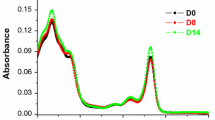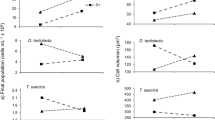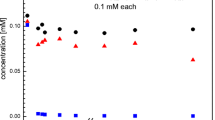Abstract
Customized metal nanoparticles are highly relevant in industrial processes, where they are used as catalysts and therefore needed on a large scale. An extremely economically and environmentally friendly way to produce metal nanoparticles is microbial biosynthesis, meaning the biosorption and bioreduction of diluted metal ions to zero valent (metal) nanoparticles. To maintain the key advantage of biosynthesis, including eco friendliness, a bioreactor (e.g., bacteria) has to be harmless by itself. Here, the ability of the cyanobacteria Anabaena sp. (SAG 12.82) is shown to fulfill both needs: bioreduction of Au3+ ions to Au0 and the subsequent formation of crystalline Au0-nanoparticles as well as absence of the release of toxic substances (e.g., anatoxin-a). The time-dependent growth of the nanoparticles is recorded by X-ray powder diffraction (XRD) and transmission electron microscopy (TEM) over a range of several days. Formation of nanoparticles starts within the first minutes at the heterocyst polysaccharide layer (HEP). After 4 h, the dominating amount of nanoparticles is found in the vegetative cells. The bioproduced nanoparticles are found in both cell types, mainly located along the thylakoid membranes of the vegetative cells and have a final average size of 9 nm within the examined timescale of a few days.








Similar content being viewed by others
References
Ahmad A, Mukherjee P, Mandal D, Senapati S, Khan MI, Kumar R, Sastry M (2002) Enzyme mediated extracellular synthesis of CdS nanoparticles by the fungus, Fusarium oxysporum. J Am Chem Soc 124:12108–12109
Aiken JD, Finke RG (1999) A review of modern transition-metal nanoclusters: their synthesis, characterization, and applications in catalysis. J Mol Catal A 145:1–44
Bansal V, Ramanathan R, Bhargava SK (2011) Fungus-mediated biological approaches towards ‘green’ synthesis of oxide nanomaterials. Aust J Chem 64:279–293
Bansal V, Bharde A, Ramanathan R, Bhargava SK (2012) Inorganic materials using ‘unusual’ microorganisms. Adv Colloid Interface Sci 179–182:150–168
Baptista MS, Vasconcelos MT (2006) Cyanobacteria metal interactions: requirements, toxicity, and ecological implications. Crit Rev Microbiol 32:127–137
Brayner R, Barberousse H, Hernadi M, Djedjat C, Yéprémian C, Coradin T, Livage J, Fiévet F, Couté A (2007) Cyanobacteria as bioreactors for the synthesis of Au, Ag, Pd, and Pt nanoparticles via an enzyme-mediated route. J Nanosci Nanotechnol 7:2696–2708
Capek I (2004) Preparation of metal nanoparticles in water-in-oil (w/o) microemulsions. Adv Colloid Interface Sci 110:49–74
Dahoumane SA, Djediat C, Yéprémian C, Couté A, Fiévet F, Coradin T, Brayner R (2012a) Recycling and adaptation of Klebsormidium flaccidum microalgae for the sustained production of gold nanoparticles. Biotechnol Bioeng 109:284–288
Dahoumane SA, Djediat C, Yéprémian C, Couté A, Fiévet F, Coradin T, Brayner R (2012b) Species selection for the design of gold nanobioreactor by photosynthetic organisms. J Nanoparticle Res 14:883–889
De Corte S, Hennebel T, De Gusseme B, Verstraete W, Boon N (2012) Bio-palladium: from metal recovery to catalytic applications. Microb Biotechnol 5:5–17
Deplanche K, Merroun ML, Casadesus M, Tran DT, Mikheenko IP, Bennett JA, Zhu J, Jones IP, Attard GA, Wood J, Selenska-Pobell S, Macaskie LE (2012) Microbial synthesis of core/shell gold/palladium nanoparticles for applications in green chemistry. J R Soc Interface 9:1705–1712
Durán Pachón L, Rothenberg G (2008) Transition-metal nanoparticles: synthesis, stability and the leaching issue. Appl Organomet Chem 22:288–299
Eriksson S, Nylén U, Rojas S, Boutonnet M (2004) Preparation of catalysts from microemulsions and their applications in heterogeneous catalysis. Appl Catal A 265:207–219
Fawell JK, Mitchell RE, Hill RE, Everett DJ (1999) The toxicity of cyanobacterial toxins in the mouse: II anatoxin-a. Hum Exp Toxicol 18:168–173
Flores E, Herrero A (2011) Compartmentalized function through cell differentiation in filamentous cyanobacteria. Nat Rev Microbiol 8:39–50
Focsan M, Ardelean II, Craciun C, Astilean S (2011) Interplay between gold nanoparticle biosynthesis and metabolic activity of cyanobacterium Synechocystis sp. PCC 6803. Nanotechnology 22:485101
Gaikwad AN, Verschuren P, Eiser E, Rothenberg G (2006) A simple method for measuring the size of metal nanoclusters in solution. J Phys Chem B 110:17437–17443
Gaikwad AN, Verschuren P, Kinge S, Rothenberg G, Eiser E (2008) Matter of age: growing anisotropic gold nanocrystals in organic media. Phys Chem Chem Phys 10:951–956
Gericke M, Pinches A (2006) Biological synthesis of metal nanoparticles. Hydrometallurgy 83:132–140
Gonzalez CM, Liu Y, Scaiano JC (2009) Photochemical strategies for the facile synthesis of gold-silver alloy and core-shell bimetallic nanoparticles. J Phys Chem C 113:11861–11867
Hsu S-W, On K, Gao B, Tao AR (2011) Polyelectrolyte-templated synthesis of bimetallic nanoparticles. Langmuir 27:8494–8499
Iravani S (2011) Green synthesis of metal nanoparticles using plants. Green Chem 13:2638–2650
Karnani RL, Chowdhary A (2013) Biosynthesis of silver nanoparticle by eco-friendly method. Indian J Nano Sci 1:25–31
Konishi Y, Tsukiyama T, Ohno K, Saitoh N, Nomura T, Nagamine S (2006) Intracellular recovery of gold by microbial reduction of AuCl4-ions using the anaerobic bacterium Shewanella algae. Hydrometallurgy 81:24–29
Korbekandi H, Iravani S, Abbasi S (2009) Production of nanoparticles using organisms. Crit Rev Biotechnol 29:279–306
Langford JI, Wilson AJC (1978) Scherrer after sixty years: a survey and some new results in the determination of crystallite size. J Appl Crystallogr 11:102–113
Le Bail A, Duroy H, Fourquet JL (1988) Ab-initio structure determination of LiSbWO6 by X-ray powder diffraction. Mater Res Bull 23:447–452
Lengke MF, Fleet ME, Southam G (2006a) Morphology of gold nanoparticles synthesized by filamentous cyanobacteria from gold(I)–thiosulfate and gold(III)–chloride complexes. Langmuir 22:2780–2787
Lengke MF, Ravel B, Fleet ME, Wanger G, Gordon RA, Southam G (2006b) Mechanisms of gold bioaccumulation by filamentous cyanobacteria from gold(III)-chloride complex. Environ Sci Technol 40:6304–6309
Lengke MF, Fleet ME, Southarn G (2007) Synthesis of palladium nanoparticles by reaction of filamentous cyanobacterial biomass with a palladium(II) chloride complex. Langmuir 23:8982–8987
Lloyd JR (2003) Microbial reduction of metals and radionuclides. FEMS Microbiol Rev 27:411–425
Luz A, Malek-Luz A, Feldmann C (2013) Photochemical synthesis of particulate main-group elements and compounds. Chem Mater 25:202–209
Mohanpuria P, Rana NK, Yadav SK (2008) Biosynthesis of nanoparticles: technological concepts and future applications. J Nanopart Res 10:507–517
Narayanan KB, Sakthivel N (2010) Biological synthesis of metal nanoparticles by microbes. Adv Colloid Interface Sci 156:1–13
Petricek V, Dusek M, Palatinus L (2006) Jana 2006. The crystallographic computing system. Institute of Physics, Praha
Rai M, Duran N (2011) Metal nanoparticles in microbiology. Springer-Verlag, Berlin
Ramanathan R, O’Mullane AP, Parikh RY, Smooker PM, Bhargava SK, Bansal V (2011) Bacterial kinetics-controlled shape-directed biosynthesis of silver nanoplates using Morganella psychrotolerans. Langmuir 27:714–719
Singh M, Kalaivani R, Manikandan S, Sangeetha N, Kumaraguru AK (2013) Facile green synthesis of variable metallic gold nanoparticle using Padina gymnospora, a brown marine macroalga. Appl Nanosci 3:145–151
Sintubin L, Windt W, Dick J, Mast J, Ha D, Verstraete W, Boon N (2009) Lactic acid bacteria as reducing and capping agent for the fast and efficient production of silver nanoparticles. Appl Microbiol Biotechnol 84:741–749
Smith DK, Jenkins R (1996) International centre for diffraction data (ICDD): powder diffraction file PDF-2, release 2003 reference number 00-004-0784. J Res Natl Inst Stand Technol 101:259
Swanson HE, Tatge E (1953). Natl. Bur. Stand. (U.S.) Circular 539:33
Tao F, Zhang S, Nguyen L, Zhang X (2012) Action of bimetallic nanocatalysts under reaction conditions and during catalysis: evolution of chemistry from high vacuum conditions to reaction conditions. Chem Soc Rev 41:7980–7993
Tsygankov AA (2007) Nitrogen-fixing cyanobacteria: a review. Appl Biochem Microbiol 43:250–259
Wang J, Boelens HFM, Thathagar MB, Rothenberg G (2004) In situ spectroscopic analysis of nanocluster formation. ChemPhysChem 5:93–98
Warren SC, Jackson AC, Cater-Cyker ZD, DiSalvo FJ, Wiesner U (2007) Nanoparticle synthesis via the photochemical polythiol process. J Am Chem Soc 129:10072–10073
Wegner K, Pratsinis SE, Köhler M (2004) Nanomaterialien und Nanotechnologie. In Dittmeyer R, Keim W, Kreysa G, Oberholz A (eds) Winnacker-Kuchler: Chemische Technik: Prozesse und Produkte. Band 2: Neue Technologien, 5th edn. Wiley-VCH Verlag & Co. KGaA, Weinheim
Zadvorny O, Zorin N, Gogotov I (2006) Transformation of metals and metal ions by hydrogenases from phototrophic bacteria. Arch Microbiol 184:279–285
Zhang X, Yan S, Tyagi RD, Surampalli RY (2011) Synthesis of nanoparticles by microorganisms and their application in enhancing microbiological reaction rates. Chemosphere 82:489–494
Acknowledgments
We thank Werner Manz, Jutta Meier, Alexandra Grün (Microbiology, Campus Koblenz, University Koblenz-Landau), Manoj Schulz, Rita Beel, Michael P. Schlüsener, Thomas A. Ternes (Federal Institute of Hydrology, BfG, Koblenz) for analytical support (especially anatoxin-a measurements) and helpful discussions as well as Rita Grotjahn (Cell Biology/Electron Microscopy, University Bayreuth) for technical assistance.
Author information
Authors and Affiliations
Corresponding author
Electronic supplementary material
Below is the link to the electronic supplementary material.
Rights and permissions
About this article
Cite this article
Rösken, L.M., Körsten, S., Fischer, C.B. et al. Time-dependent growth of crystalline Au0-nanoparticles in cyanobacteria as self-reproducing bioreactors: 1. Anabaena sp.. J Nanopart Res 16, 2370 (2014). https://doi.org/10.1007/s11051-014-2370-x
Received:
Accepted:
Published:
DOI: https://doi.org/10.1007/s11051-014-2370-x




